Analysis of Tyre Problems ⅡTyre Shoulder
1. Delamination between the Sidewall Rubber and Tread Rubber
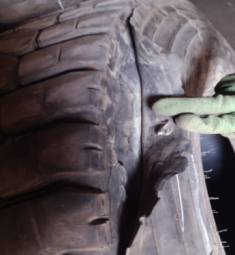
Symptoms:At the tyre shoulder, the sidewall rubber and tread rubber delaminate, and the interface was smooth.
Causes: ① In the process of tyre manufacturing, the water and gasoline were left among the parts of the steel belt.
② There were oil, dust and other impurities.
③ The pressure of the molding fluctuates.
Liability attribution: Manufacturing issues.
2. Hollow Phenomenon
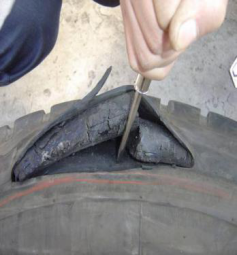
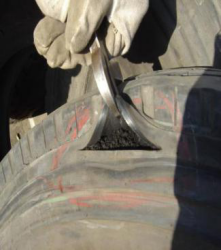
Symptoms: At the tyre shoulder, the wedge and the carcass were delaminated, and the properties of the wedge were changed and appear to be clumpy.
Causes: ① The tyre runs under high load and high speed. It deflects and deforms to generate heat. The strength of the wedge at the shoulder decreases, and the performance changes, causing delamination.
② Driving under low air pressure or mismatched load will cause excessive heat and delamination.
Liability attribution: Performance problems.
3. Delamination between Tread Rubber and Cap Ply
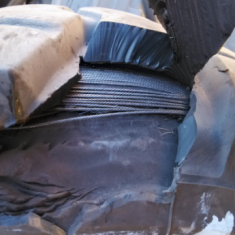
Symptoms: The delamination happens between the tread rubber and cap ply. The interface of it was smooth, sometimes accompanied by wear.
Causes: ① In the process of tyre manufacturing, the water and gasoline were left among the parts.
② In addition, there were oil, dust and other impurities.
③ Components were not compacted tightly.
Liability attribution: Manufacturing issues.
4. Loosely Delaminated Steel Belt Endpoints
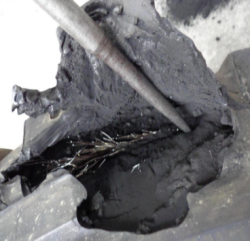
Symptoms:The steel belt and the wedge delaminated and the end points were loose and shiny, which was accompanied by friction powder.
Causes: ① In the manufacturing process, the steel belt and the wedge were not well bonded. The parts delaminate and rub against each other.The steel belt was loose and shiny.
② Insufficient tyre pressure, excessive stress and deflection on the shoulder result in loose endpoints of the steel belt. The wedge was worn in the form of powder.
Liability attribution: Performance/ Quality problems.
5. Delamination between Steel Belt and Wedge
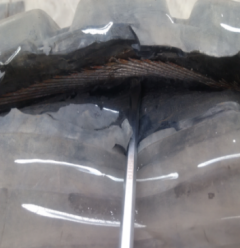
Symptoms:Delamination occurs between the steel belt and the wedge. The interface was smooth and the steel belt wires were shiny, sometimes accompanied by powder.
Causes: ① In the process of tyre manufacturing, the water and gasoline were left among the parts.
② In addition, there were oil, dust and other impurities.The parts delaminate and rub against each other.The steel belt was loose and shiny.
③ Component materials have been left for too long or the surface was frosted or the air pressure was insufficient. The shoulders were stressed, and the adhesion among the components was reduced.
Liability attribution: Performance/ Quality problems.
6. Delamination among Steel Belt
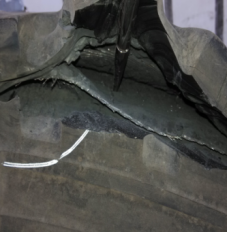
Symptoms:Delamination occurs among the layers of steel belt. The interface was smooth and the wires were shiny, sometimes accompanied by powder.
Causes: ① In the process of tyre manufacturing, the water and gasoline were left among the parts; In addition, there were oil, dust and other impurities.
② The parts delaminate and rub against each other.The steel belt was loose and shiny.
③ Insufficient tyre pressure, excessive stress and deflection on the shoulders cause delamination between the steel belt .
Liability attribution: Manufacturing/Performance issues.
7. Delamination between Tread Rubber and Wedge
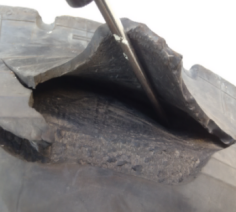
Symptoms:Delamination occurs between the tread rubber and wedge. The interface was smooth.
Causes: ① In the process of tyre manufacturing, the water and gasoline were left among the parts; In addition,
there were oil, dust and other impurities, causing insufficient adhesion.
② Component materials have been left for too long or the surface was frosted.
Liability attribution: Manufacturing/Performance issues.
8. Delamination between Carcass and Wedge
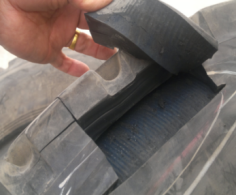
Symptoms:Delamination occurs between the carcass cord and wedge. The interface was smooth.
Causes: ① In the process of tyre manufacturing, the water and gasoline were left among the parts; In addition, there were oil, dust and other impurities, causing insufficient adhesion.
② Component materials have been left for too long or the surface was frosted.
Liability attribution: Manufacturing issues.
9. Hollow Shoulders(Heat Generation)
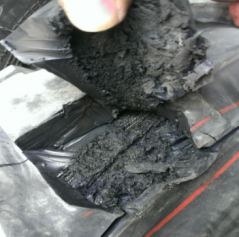
Symptoms:The rubber properties of the shoulders change, and oily substances precipitate out in severe cases.
Causes: ① Long-haul driving at high speed under high load for a long time. The shoulders generate heat and the rubber’s performance changes.
② Driving under low air pressure or mismatched load at high speed will cause excessive heat and delamination.
Liability attribution: Performance/ Usage problems.
10. Piercing Causes Hollow shoulders
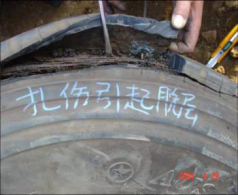
Symptoms:The shoulder of the tyre was bulged and delaminated, but there were obvious stab marks. In severe cases, the wires of the steel belt were partially broken or penetrated.
Causes: The shoulder was stabbed by sharp objects such as stones, iron blocks, bolts, nails, etc. The steel wire rusted due to water or air and the strength was reduced, resulting in delamination of the shoulder.
Liability attribution: Usage problems.
11. Shoulder Puncture
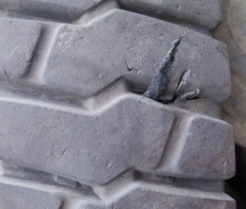
Symptoms:The endpoints of the steel belt on the shoulder were exposed. In severe cases, the steel wire breaks, and there were obvious stab marks on the surface.
Causes: When the vehicle was running, the tire was punctured by sharp objects on the steel belt or carcass wire, which can cause blasting in severe cases.
Liability attribution: Usage problems.
12. Bad Appearance
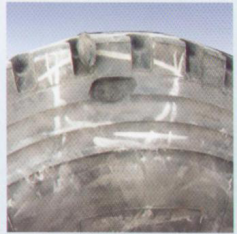
Symptoms:There were defects on the surface of the tyre, such as lack of glue, impurities. It doesn’t meet the requirements after repair.
Causes: ① There were bubbles or impurities in the manufacturing process.
② The mould was not rinsed clean.
Liability attribution: Manufacturing issues.
13. Shoulder Broken(Blunt Force)
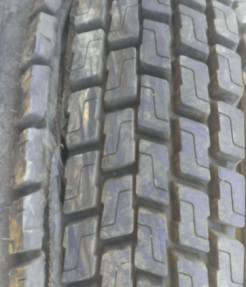
Symptoms:The shoulder of the tyre was cut by external objects, and there were obvious signs of tearing or partial fracture in severe cases.
Causes:The bottom of the groove was damaged by obstacles because of vehicle’s fast speed and turning. In severe cases, the belt was cut and the blast occurs.
Liability attribution: Usage problems.
14. Shoulder Broken(Sharpness Force)
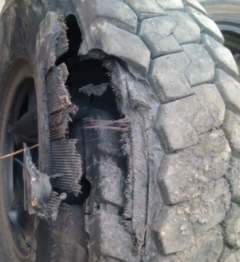
Symptoms:The shoulder of the tyre was cut by external objects, and there were obvious signs of tearing or wire fracture in severe cases.
Causes:The bottom of the groove was damaged by obstacles because of vehicle’s fast speed and turning. In severe cases, the belt was cut and the blast occurs.
Liability attribution: Usage problems.
15. Shoulder Gnawing
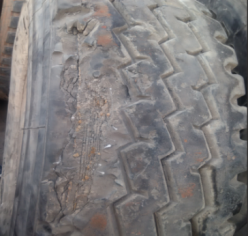
Symptoms: Tyre’s shoulder was gnawed by obstacles. The shoulder has obvious signs of tear or serious fracture of wire.
Causes: ① The tyre was stabbed by obstacles or torn by a roadbed squeeze.
② The vehicle was overloaded and the tyre slip under heavy load, which caused partial stress on the block and eventually collapsed.
Liability attribution: Usage problems.
16. Shoulder Puncture
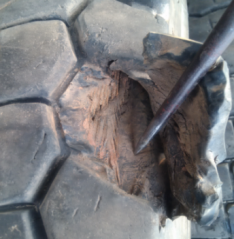
Symptoms:The shoulder was punctured by sharp objects, and the wires of steel belt or carcass were broken and torn.
Causes: During driving, the tyre was stabbed by sharp obstacles or turned sharply and was squeezed by roadbed.
Liability attribution: Usage problems.
17. Cut and Blast of Shoulder
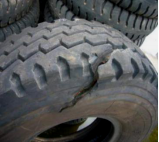
Symptoms:The shoulder was cut by sharp objects and the wires of steel belt and the carcass were broken. There were obvious cutting marks and no delamination among the components.
Causes: During driving, the tyre was cut by sharp obstacles and the wires were broken, causing blasting.
Liability attribution: Usage problems.
18. Hollow Shoulder Causaged by Stabbing
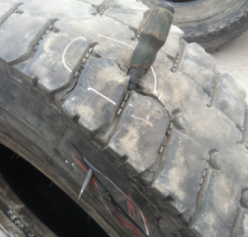
Symptoms:The shoulder of the tyre was punctured by sharp objects, causing bulging. In severe cases, the steel belt was partially broken.
Causes:During driving, the tyre shoulders were stabbed by sharp (stone, iron nails, etc.) obstacles, and sometimes the wires of steel belt were partially broken. If continue to drive,the stress will causage delamination.
Liability attribution: Usage problems.